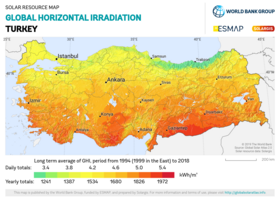
Turkey’s sunny climate possesses a high solar energy potential, specifically in the South Eastern Anatolia and Mediterranean regions.[3] Solar power is a growing part of renewable energy in the country, with 19 gigawatts (GW) of solar panels[4]: section 4.2.1 generating 6% of the country's electricity.[5]: 13 Solar thermal is also important.[6]: 29
Although similarly sunny, by 2021 Turkey had installed far less solar power than Spain.[7]: 49 Solar power subsidizes coal and fossil gas power.[8]: 9 Every gigawatt of solar power installed would save over US$100 million on gas import costs,[9] and more of the country's electricity might be exported.[10]
Most new solar power is tendered as part of hybrid power plants.[11][12] Building new solar power plants would be cheaper than running existing import-dependent coal plants if they were not subsidized.[13] However, think tank Ember has listed several obstacles to building utility-scale solar plants, such as insufficient new grid capacity for solar power at transformers,[14] a 50 MW cap for any single solar power plant's installed capacity, and large consumers not allowed to sign long-term power purchase agreements for new solar installations.[13] Ember says there is technical potential for 120 GW of rooftop solar, almost 10 times 2023 capacity, which they say could generate 45% of the country’s 2022 demand.[15]
- ^ Cite error: The named reference
:9was invoked but never defined (see the help page). - ^ Acaroğlu, Hakan; García Márquez, Fausto Pedro (8 May 2022). "A life-cycle cost analysis of High Voltage Direct Current utilization for solar energy systems: The case study in Turkey". Journal of Cleaner Production. 360: 132128. Bibcode:2022JCPro.36032128A. doi:10.1016/j.jclepro.2022.132128. ISSN 0959-6526.
- ^ Dawood, Kamran (2016). "Hybrid wind-solar reliable solution for Turkey to meet electric demand". Balkan Journal of Electrical and Computer Engineering. 4 (2): 62–66. doi:10.17694/bajece.06954 (inactive 1 November 2024).
{{cite journal}}: CS1 maint: DOI inactive as of November 2024 (link) - ^ First Biennial Transparency Report of Türkiye (PDF) (Report). Ministry of Environment, Urbanisation and Climate Change. November 2024.
- ^ Türkiye Electricity Review 2024 (PDF) (Report). Ember.
- ^ Cite error: The named reference
:02was invoked but never defined (see the help page). - ^ Overview of the Turkish Electricity Market (Report). PricewaterhouseCoopers. October 2021. Archived from the original on 28 November 2021. Retrieved 28 November 2021.
- ^ "2022 energy outlook" (PDF). Industrial Development Bank of Turkey.
transferring money from solar, wind and hydroelectric power plants with low operating costs to power plants with high operating costs such as imported coal and natural gas
- ^ "Solar is key in reducing Turkish gas imports". Hürriyet Daily News. 19 February 2020. Archived from the original on 6 April 2020. Retrieved 20 September 2020.
- ^ Matalucci, Sergio (30 March 2022). "Turkey targets Balkans and EU renewables markets". Deutsche Welle. Retrieved 19 May 2022.
- ^ Başgül, Erdem (16 May 2022). "Hot Topics In Turkish Renewable Energy Market". Mondaq. Retrieved 17 May 2022.
- ^ Todorović, Igor (8 March 2022). "Hybrid power plants dominate Turkey's new 2.8 GW grid capacity allocation". Balkan Green Energy News. Retrieved 7 July 2022.
- ^ a b "Turkey: New wind and solar power now cheaper than running existing coal plants relying on imports". Ember. 27 September 2021. Archived from the original on 29 September 2021. Retrieved 29 September 2021.
- ^ "Türkiye Electricity Review 2023". Ember. 13 March 2023. Retrieved 29 March 2023.
- ^ "Türkiye can expand solar by 120 GW through rooftops". Ember. 11 December 2023. Retrieved 28 December 2023.